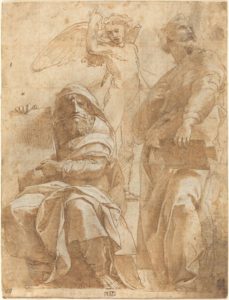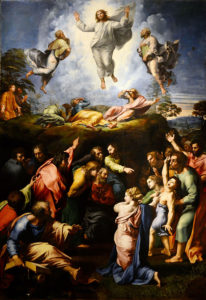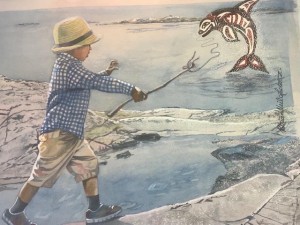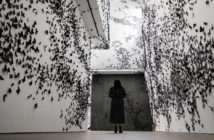Dear Artist,
“The Matthew Effect” in economics was named after the verse in Matthew in the New Testament of the Christian bible: “For unto every one that hath shall be given, and he shall have abundance: but from him that hath not shall be taken away even that which he hath.” (25:29) A popular way of saying this is, “The rich get richer and the poor get poorer.” The Matthew Effect as applied to education was first described in 1990 by Canadian psychologist Keith Stanovich. You can get the idea with all the talk these days about the importance of third grade. Children who move into fourth grade without knowing how to read suffer significant disadvantages for the rest of their lives. Learning to read is the vital precursor to reading to learn. Poor readers drop out. Later on in life, good readers get the good stuff, and poor readers don’t.

The Prophets Hosea and Jonah, ca. 1510
Pen and brown ink with brown wash over black chalk, heightened with white and squared for transfer on laid paper
10 5/16 × 7 7/8 inches
by Raphael (1483 – 1520)
The Matthew Effect can be applied to art. Historically, would-be artists who didn’t learn the basics of drawing, composition, colour and form put themselves at a disadvantage. But with the widespread democratization of art, particularly in the Western hemisphere, folks these days often feel self-expression is up ahead of proficiency. It seems many artists are simply educated with a sense of entitlement and audacity. In many places, big, decorative art is popular. Artists with very little training or academic instincts can often make effective, even sensitive, wall-fillers that make people happy. One of my more conservative dealers calls it “the end of connoisseurship.” He tells me people are not looking so closely for exquisite rendering, good drawing or the skillful nailing of light and shadow. “Right now they want ’em mighty, moody, and splashy,” he says. “Because traditional skills aren’t so respected anymore,” my dealer says, “there’s an industry in teaching people to be amateurs.”
As he said this I was remembering Picasso’s remark: “It took me four years to paint like Raphael, but a lifetime to paint like a child.” I’m curious about this. Is “painting like a child” just a trend? Are skill, technique, and connoisseurship truly on the endangered list? If so, what is this doing to people?
Best regards,
Robert
PS: “Slow reading acquisition has cognitive, behavioral, and motivational consequences that slow the development of other cognitive skills and inhibit performance on many tasks.” (Keith E. Stanovich, Department of Human Development and Applied Psychology, University of Toronto)
Esoterica: Another friend regularly attends courses where everyone is encouraged to throw paint onto giant, inexpensive surfaces — often from a lineup of commonly-shared pots of colour. The idea of these events is to free up the creator within, express oneself, shake out demons, and have a good time. Colour mixing and other basics are not part of the curriculum. After a weekend of emoting and splashing, my friend asked if she could bring her results to me for a crit. In a diplomatic manner I pointed out what I thought were their strengths and weaknesses. After a while she hesitantly asked, “How much do you think I should charge for them?”
This letter was originally published as “The Matthew Effect” on January 29, 2013.
Have you considered a Premium Artist Listing? With each letter, an artist is featured at the bottom of this page. The Premium Artist Listings are a means of connecting artist subscribers through their work. Proceeds from each listing contribute to the production of The Painter’s Keys.
“Skill is the unified force of experience, intellect and passion in their operation.” (John Ruskin)
Featured Artist
My Life “HAS BEEN FULL OF JOY ! ….. I believe the ability handed down to me through my family’s genes have blessed me with the gift of happiness as well as a talent that I have used continuously…. since my first memories ….. that of being able to draw almost anything I have set my mind to; whether it was out of my inner conscience (includes lots of sketching & erasing) …..I call it practice ! Or from photos. I have drawn anything and everything.
Drawing every day is what it takes! Being a Portrait Painter, I rely on using my camera….. it has given me a good sense of Composition….. Balance, proportion and Perspective. I love painting Portraits of Fishing Boats …. And being a careful photographer, insures I retain all the important details. The wood grain of the dock; the moving water reflecting on the white hulls in sunlight….. Beautiful detail!








28 Comments
Very true… Thanks for sharing.
“I don’t play accurately — anyone can play accurately — but I play with wonderful expression.”
__Oscar Wilde
It’s much easier to be different than good. Still working to be good!
I went to a university for a degree in Studio Drawing and Painting, in which Abstract Expressionism was not only the favored mode of expression, but pretty much the rule. Painting was “do what you feel.” One drawing instructor kept me anchored in representational drawing and working from life. Otherwise, my painting instruction was what I carried out myself after graduation, primarily through my teaching at the secondary school level, during which I presented to students those lessons that I wanted to learn myself. I believe today that the best way to educate one’s self in painting is through working with a dedicated and experienced professional, that that kind of mentorship is superior in every way to being educated in the latest trends. Great letter, Robert! Painting is not dead, and neither should be the fundamentals that make great painting possible.
I so agree, when I was in art school in Toronto, it took until nearly to the end of the first year just to convince our instructor that we needed to learn perspective…unfortunately Robert was right, there is a movement for ‘do your own thing, no need for fundamentals’…but it impedes many who otherwise would greatly expand their expressionism.
I am such a fan of this site. This is a wonderful essay, summing up late 20th c. art.
I was a victim of the conceptual art movement. We didn’t even have to make stuff, we just had to have the idea. Got a BFA in that, though there were some good painting and drawing teachers who were ready to retire. I learned a lot f from them.
My first teaching job was elementary school art, 8 grades. I worked with a brilliant team, who put together a real art program. It was there that I learned to draw, to paint, to make a glorious mess and then to clean it all up before the classroom teacher came back. Those years have carried me through my teaching for another 40 years with many kinds of gigs: College teaching, continuing ed, more children, and many workshops all over the country. The ideas are critical, but the skills to express them must also be there. You can’t write a book if you don’t know grammar; you can’t dance if you don’t learn the choreography, and you can’t play the piano if you don’t know where the notes are.
Love me some Robert. Been a fan of this newsletter for over a decade. Unfortunately, he’s got it wrong here, and it’s another example of people bending quotations or historical docs to prove some argument. The argument that Robert has made is spot on (as I continually tell my students), but the quotations he uses don’t support the message he’s trying to impart.. When Picasso made the statement about painting like a child, he wasn’t advocating for an unlearned approach, just the opposite. As Charlie Parker once said (paraphrasing), “Spend your life learning your instrument, then forget all that shit, and just play.” Which is what Picasso did. And the Bible quotation from Matthew is a complete misrepresentation of what that passage means. Mixed messages here.
Actually what the Bible verse means is that if you take responsibility for what you are given and expand and do something better with it than more will be given to you. The reverse is if you can’t do good with the one thing you are given then it will be taken away from you and given to the one that will. That is usually the one that was given more because you can count on him/her to do more with what he/she was given.
The same applies to business, to life to anything really. If you don’t care about what you are given then why should anyone bother to give you more.
Thanks for the thoughtful reply. I don’t agree with your interpretation of what the Bible verse “actually” means….but you’ve every right to interpret it (as Robert has done) in any way that makes sense to you…
Agree 100%! Thank you for another wonderful installment! =) Now I’m self conscious and feel like I need to go back to art school. LOL! Interesting that the term “Matthew Effect” gets pegged to *that* specific verse out of the entire contents of the book of Matthew, seeing that the book of Matthew also contains the story of the birth of Jesus Christ. Maybe I missed something – my reading comprehension is probably not very good. Haha! ;) Hope everyone has a wonderful day and stays warm!
Still very timely! Great comments as well… I received my BFA during the New Realist upsurge. It seems we spent half our time drawing from models even though all sorts of modernist work was acceptable.
Now the superficial work of projecting your image and tracing, simply pouring paint , stencilling and copying are all saleable skill sets.
But really learning to draw builds character. It gives a depth to all else.
I too have been noticing an uptick in the number of artists launching careers on paintings where they have projected their photograph onto the canvas and then painted it in as if it were an elaborate colouring book. I often wonder if they just don’t have the skills to create the scale of the work any other way or if it is just a shortcut practice to be able to complete the paintings more quickly. The work definitely has an odd photographic look to it even though it is a painting. Personally, doing the work would be incredibly boring I think and boarders on being a human printing machine. But it does sell and so do the prints of the work if the painter is a decent enough photographer to get an interesting reference to copy. So there is a market. I just can imagine wanting to do the paintings in this manner. It would be too much like the 1.5 inch painting edges which is my least favourite painting task. But each to their own. We all approach life and painting in our own unique way.
In regard to the above quote, “There’s an industry in teaching people to be amateurs.” I have been an art therapist for 34 years. Helping people to express themselves artistically, is not the same as “teaching people to be amateurs.” It is my belief that art making is inherently good for us. Art making used to be more commonplace in previous times with people spending leisure time drawing, painting watercolors, embroidering, etc. For many cultures art has been an integral part of their society with the making of pottery, clothing, ritual objects. While I agree that throwing paint against the wall is pretty silly, I do think that it’s ok to be an amateur and to immerse yourself in the artistic process.
I have seen such a therapy class in a mental hospital facility I visited as an art student, it was a wonderful place. I’m sure that nobody denies the positive aspects of making art, especially regarding people with various problems and in a vulnerable position, looking for comport and beauty in their lives. I have much sympathy for them and their therapists of course, I wish them (including you) all the best.
What is discussed here is I believe the notion that there is a market for “art” that is made purely to make profit without the effort of learning, made just with that in mind. The question about price that is mentioned in the last part of this article sounds so cold and calculated it made me shiver. Tha “artist” wasn’t going to learn or even purely enjoy the process, but was focused on making money and selling their creation to anybody willing to pay. It was clearly a person who thought they could gain profit effortlessly. Which overall is a mindset that pushes people down the path of materialistic thinking, possibly depression. A vicious circle, don’t you think? Not the outcome one could possibly wish for.
I really appreciate this letter. I am wondering though what happens if the technical skills are combined with the expressive. What if it truly is a both/and situation for getting interesting results? I love loose expressive brushstrokes that are refined with selected detail on a well composed canvas. Even the occasional drip or pour can add something freeing and unexpected without loosing the strength of a freehand representative rendering. Just a thought.
“To him, all good things trout, as well as eternal salvation, come by grace, and grace comes by art, and art does not come easy.” – Norman Mcclean
As someone who majored in art in the 60’s, I struggled with the fact that my artistic instincts lay with artists like Andrew Wyeth and even Norman Rockwell. Then, the expressionists ruled, and Rockwell was a dirty word. Looking back, I now see that even the abstract artists had some knowledge of color, form and structure. Those works today seem tame. I keep telling myself that I need to get with it…to jump on the new bandwagon and appreciate a banana duck taped to a wall. But you know what? At 77, that’s probably not going to happen. I am NOT for censorship, and know that the progression of art will continue, and no doubt become even more extreme due to the rise of things like NFTs. But I also believe there are many artists like myself who silently struggle on and do the work that we feel we must, but more importantly, enjoy.
Amen.
Yes
Yup! Smart! I had to look it up; didn’t know about NFT’s. My therapist tells me to paint, even though I don’t have an intention to be one so much any more and I just find it helps me pass through if you will and brings fluidity. God bless the child that has his own.
I really felt “ok”after reading your letter and the many comments. Doing art in a demanding and challenging way, working my skills nourrishes something in me. I am 75 and can appreciate the splashes of paint but living with a painting for hours and days brings its own joy.
Oh man, as soon as I read this letter I anticipated the comments. I’ve been a published photographer for 40 years and when digital cameras took over it was a game changer. I think it was a world changer. The sheer volume of images, etc. Was it better when Penn and Avedon ruled? Don’t ask me! Still, you gotta love the game!
So the question is, do we want to be remembered as skilled and educated artists who left artwork that impresses the the list makers of great artists in history… or…. do we want to be remembered as “artists with very little training or academic instincts who often made effective, even sensitive, wall-fillers that make people happy. ” I like to think I strive to be a little of both.
So appropriate! Thank you for sharing.
Wonderful summary of where things seem to be going in our current culture that has way too much given to them. and I don’t see nearly the effort put into much of anything anymore. it’s all too easy. I don’t know if it’s because we’ve kind of slacked off on self discipline or that we’ve been rewarding mediocrity for so long or we just don’t know enough of our own history and without knowing our history not just in art but in everything, we really can’t build our future.,, it’s like everybody’s treading water putting in a little effort but not getting very far. I never had a crack at art school. it just wasn’t in the cards . but it doesn’t mean I didn’t learn how to draw and paint . I’ve been drawing since I was a kid and I took the class here and there whenever I could afford it or get there and I have had wonderful mentors….. other artists encouraged me …..and I’m going to be 80 this year and I’m doing what may be my last (I don’t know) one woman show but it’s all new stuff. Brand new and that’s what Art has meant to me ……all my life….. I just keep digging into processes and subject matter and I’ve probably mounted at least six or seven one-woman shows. I’m not on the streets of New York and no major Gallery represents me and I don’t give a shit. I like what I do and so do other people and maybe someday someone will think wow OK well that’s some kind of painting. but it doesn’t matter to me because getting it done isn’t the goal . the process is the goal…. and i’ve been at it now for 60 years and to be doing something completely new and different which happens to be combining the energetics piece of music (the chords) and colors and their energy into a painting whether it’s abstract or contemporary realism or expressionism doesn’t matter. Watercolor soil pastels charcoal it doesn’t matter fabric bring it on. It’s all wonderful and it’s so thrilling to see the results. and I just keep going because that’s what I’m supposed to be doing. Other people I guess are supposed to be doing something else .,that’s their business.? that’s their job . my job is to do what I’ve been put here to do and that’s what I’m doing.
Wonderfully written. To whom must we speak … has been a driving motto for me many years.
All good wishes for your upcoming show!
Raphael (1843 – 1520)
Raphael (1483 – 1520)
Sign me, a slow reader … still working at my drawing skills, with faith and vision that the result of the effort will be its own reward — besides I like the challenge!
Damien Hirst’s ‘Spinning Pictures’ sums this up beautifully.